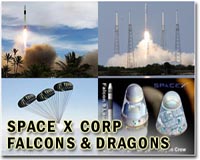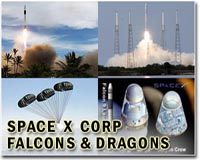SpaceX reused the same first-stage Falcon 9 rocket booster for the sixth time in a launch from Florida Tuesday morning, setting a record for the launch industry.
The rocket carried 58 of the company’s Starlink satellites into space, along with three small Earth-imaging SkySat satellites for San Francisco-based Planet (formerly Planet Labs).
The rocket lifted off as planned at 10:31 a.m. EDT into a partly cloudy sky from Launch Complex 40 at Cape Canaveral Air Force Station, adjacent to Kennedy Space Center.
SpaceX also recovered the booster successfully by landing it on a barge in the Atlantic Ocean — the sixth recovery of that booster. The Starlink satellites deployed into orbit about 46 minutes after launch.
SpaceX said it caught one of two rocket nose-cone halves — or fairings — in a net aboard another ship. The other fairing fell into the ocean and is to be recovered later.
“This will mark the first time that we’re flying a booster for its sixth mission — that’s the bottom two-thirds of the vehicle,” SpaceX engineer Kate Tice said in a launch broadcast.
“And if you look closely you can actually see … there are soot markings still on the vehicle from its previous five flights.”
The company has said that it can use a Falcon 9 booster about 10 times without a major overhaul.
The booster launched three previous Starlink missions and two other communications satellites for customers since 2018. Elon Musk’s SpaceX started to reuse boosters the year before, saying that reduces launch costs.
SpaceX said the mission was their 90th launch on a Falcon 9 rocket. It was also the second Starlink launch this year to carry SkySats.
Former NASA scientists Will Marshall, Robbie Schingler and Chris Boshuizen founded the company in 2010, “with a goal to use space to enhance life on Earth,” according to the company.
Planet said it has sent more than 100 satellites into orbit — some the size of a shoebox — collecting almost 100 million square miles of imagery daily.
The SkySat spacecraft are part of Planet’s Earth-imaging constellation. The company provides surveillance and images of the planet’s surface, updated frequently for emergency service providers, security firms and other customers.
NASA, SpaceX targeting October for next astronaut launch
Houston TX (SPX) Aug 16, 2020
NASA and SpaceX are targeting no earlier than Oct. 23 for the first operational flight with astronauts of the Crew Dragon spacecraft and Falcon 9 rocket to the International Space Station as a part of the agency’s Commercial Crew Program. NASA’s SpaceX Crew-1 mission will be the first of regular rotational missions to the space station following completion of NASA certification.
The mission will carry Crew Dragon commander Michael Hopkins, pilot Victor Glover, and mission specialist Shannon Walker … read more
– Advertisement –


